The coca farmers on these steep mountain slopes have long felt their livelihood and Indian identity threatened by US-backed efforts to uproot the crop that makes cocaine.
Now they are pinning their hopes on one of their own -- an Indian coca farmer who is also the front-runner for the presidency.
Evo Morales promises that if elected on Dec. 4, he will decriminalize all coca farming. That would mean an end to a decade-old crop eradication program that has led to clashes between farmers and soldiers in which dozens have died.
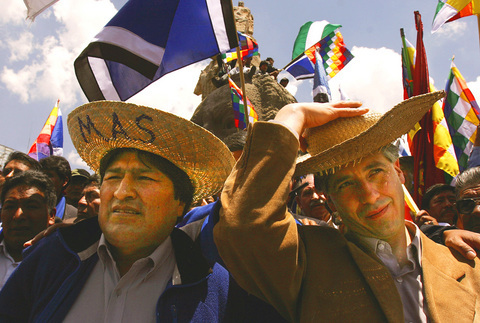
PHOTO: AP
He would also be Bolivia's first Indian president, and his leftist politics -- he's a close friend of Venezuelan President Hugo Chavez -- would move yet another Latin American government leftward after Brazil, Argentina, Chile and Uruguay.
A Morales victory may worry Washington, as well as many governments in Europe, Bolivian cocaine's chief market. But the cocaleros, as coca farmers are known, are delighted at the prospect.
"Many Indians are very hopeful that these elections can change history," said Issaes Alvarez, a 23-year-old cocalero and town councilor in Asunta, in a coca-growing region northeast of La Paz, the capital. "If the eradication continues there will be a massacre, there will be death, there will be violations of human rights."
Indians are the majority in this nation of 8.5 million, and for centuries, those in the Andean highlands have chewed the coca leaf to stave off hunger pangs and work up energy, used it in religious ceremonies and boiled it into medicinal tea. It's sold legally in supermarkets throughout Bolivia and Peru, and is served as tea in cafes.
But coca is also the main ingredient of cocaine, and the Bolivian and US governments are convinced that a growing amount of the crop is being turned into drugs. Bolivia, the world's No. 3 coca power after Colombia and Peru, produced up to 106.2 tonnes of cocaine last year, up 35 percent from 2003, according to the latest UN World Drug Report.
Morales' family is one of many who migrated from Bolivia's poor western highlands, where they struggled along by herding llamas and growing potatoes. In the tropical Chapare region, in southeast Bolivia, Morales began growing coca, became a trade union official and finally, in 1993, president of the cocalero organization. He still operates a coca farm.
Chapare is his power base, and it was here that he led the often violent clashes with government forces over coca eradication. He was elected to Congress in 1997 and narrowly lost the presidential race to Gonzalo Sanchez de Lozada in 2002. He was a key figure in protests that brought down Sanchez de Lozada in 2003 and his successor, Carlos Mesa, in June.
Opinion polls give him a slight edge over conservative former president Jorge Quiroga.
In the last election, then US Ambassador Manuel Rocha criticized Morales, only to see him shoot up in the polls. Morales jokingly called Rocha his "campaign chief." This time Washington has kept silent about the election, but Morales has said plenty about Washington.
"Thanks to coca, we've made it through the endless suffering caused by the white man's infamous war on drugs," he wrote on his Web site.
But meanwhile, the laborious work of pulling out plants by hand continues. Last year, troops uprooted 8,320 hectares in Chapare -- 83 percent of the total.
Los Yungas, about 480km away, is the only region where growing is legal. The government lets cocaleros farm 11,840 hectares, but the UN Illicit Crop Monitoring Program estimates that an additional 5,200 hectares are planted. The hillsides of Asunta, for example, are an endless patchwork of illegal green coca bushes.
Now the government is eyeing Los Yungas too. Next month it will begin paying some farmers to destroy their plants and encourage them to switch crops voluntarily. But although authorities promise there'll be no uprooting by force, tempers are running high. After the army enlarged a checkpoint to track illegal drugs out of Los Yungas, cocaleros threatened a blockade, fearing eradication was coming.
Farmers say alternative crops such as coffee and bananas are harder to grow and transport, and fetch a lower price. They are staking their hopes on Morales.
"We're not going to let up. We'll keep fighting no matter what the consequences, because there's no other product that sustains us like coca," said Asunta farmer Juan Condori. "It's the only crop that supports the whole family."
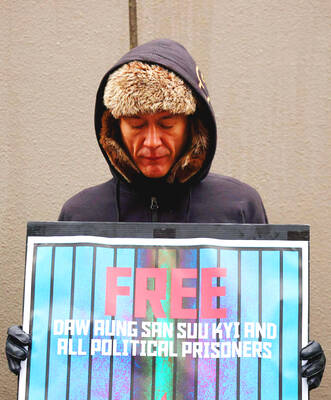
The Burmese junta has said that detained former leader Aung San Suu Kyi is “in good health,” a day after her son said he has received little information about the 80-year-old’s condition and fears she could die without him knowing. In an interview in Tokyo earlier this week, Kim Aris said he had not heard from his mother in years and believes she is being held incommunicado in the capital, Naypyidaw. Aung San Suu Kyi, a Nobel Peace Prize laureate, was detained after a 2021 military coup that ousted her elected civilian government and sparked a civil war. She is serving a
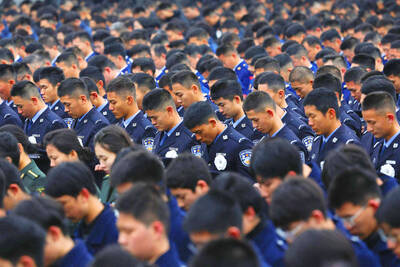
China yesterday held a low-key memorial ceremony for the 1937 Nanjing Massacre, with Chinese President Xi Jinping (習近平) not attending, despite a diplomatic crisis between Beijing and Tokyo over Taiwan. Beijing has raged at Tokyo since Japanese Prime Minister Sanae Takaichi last month said that a hypothetical Chinese attack on Taiwan could trigger a military response from Japan. China and Japan have long sparred over their painful history. China consistently reminds its people of the 1937 Nanjing Massacre, in which it says Japanese troops killed 300,000 people in what was then its capital. A post-World War II Allied tribunal put the death toll
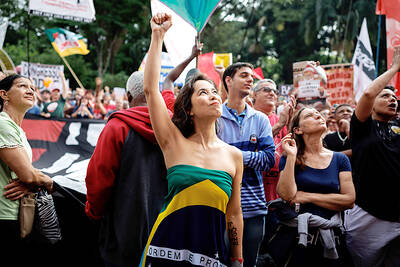
‘NO AMNESTY’: Tens of thousands of people joined the rally against a bill that would slash the former president’s prison term; President Lula has said he would veto the bill Tens of thousands of Brazilians on Sunday demonstrated against a bill that advanced in Congress this week that would reduce the time former president Jair Bolsonaro spends behind bars following his sentence of more than 27 years for attempting a coup. Protests took place in the capital, Brasilia, and in other major cities across the nation, including Sao Paulo, Florianopolis, Salvador and Recife. On Copacabana’s boardwalk in Rio de Janeiro, crowds composed of left-wing voters chanted “No amnesty” and “Out with Hugo Motta,” a reference to the speaker of the lower house, which approved the bill on Wednesday last week. It is
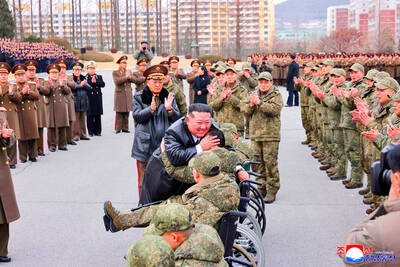
FALLEN: The nine soldiers who were killed while carrying out combat and engineering tasks in Russia were given the title of Hero of the Democratic People’s Republic of Korea North Korean leader Kim Jong-un attended a welcoming ceremony for an army engineering unit that had returned home after carrying out duties in Russia, North Korean state media KCNA reported on Saturday. In a speech carried by KCNA, Kim praised officers and soldiers of the 528th Regiment of Engineers of the Korean People’s Army (KPA) for “heroic” conduct and “mass heroism” in fulfilling orders issued by the ruling Workers’ Party of Korea during a 120-day overseas deployment. Video footage released by North Korea showed uniformed soldiers disembarking from an aircraft, Kim hugging a soldier seated in a wheelchair, and soldiers and officials